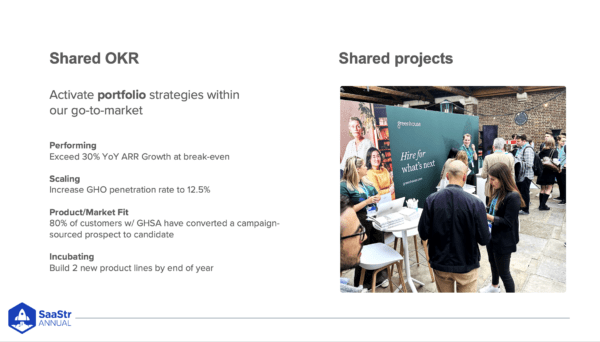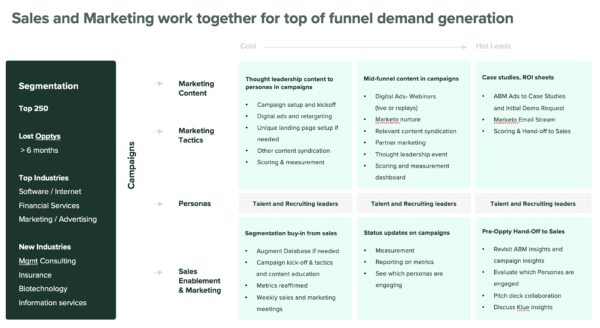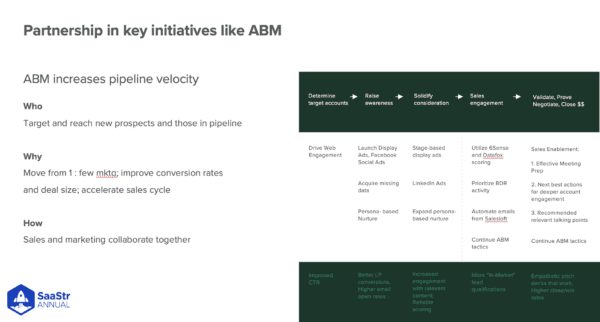Theoretically, the relationship between sales and marketing should be easy –– after all, these teams are responsible for pulling in more business and increasing revenue. However, it is often the case that relationships are complicated between these teams, and sometimes they can even butt heads.
Unfortunately, this type of tension is all too common and plagues many companies. But there is hope. Greenhouse CMO, Carin Van Vuuren, and VP of Enterprise Revenue, Ankur Passi, share their approach to bridging the communication gap to bring the traditional frenemies together.
Reconciling the Past and Present
Experience can be the best teacher, and Passi can draw on his past career as a sales leader at an early-stage company. During this time, Passi observed gaps in goals and communication in the relationship between sales and marketing and realized that it hindered execution: “Oftentimes, you’ll find that marketing is so focused on lead generation, so focused on a marketing qualified lead when in reality, all that sales cares about is the opportunity and a qualified opportunity at that.”’
The lack of joint efforts in planning and strategy created fragmented attempts at campaigns and conversions. Passi continues, “So we’ve often found that sales and marketing are on two different pages because they are executing and working in complete silos, and they’re not project planning together.”
While it is appropriate that marketing focuses on MQLs and lead generation, they also have a much larger remit to focus on general brand awareness and carrying that through to lots of different areas. As a CMO, Van Vuuren understands this all too well, saying, “As marketers, we can care a lot about the metrics around awareness, audience reach, and database-building and all of those campaign metrics. But the thing that we really need to ensure is that our sales and marketing teams are aligned on the core metrics.”
Those core metrics lie within the funnel rather than top-of-the-funnel MQLs. Marketing and sales should focus on moving the likeliest sales opps through the mid-funnel to the conversion point. Van Vuuren comments, “I think there’s an opportunity there for us as sales and marketing leaders to align and get off the hamster wheel of leads and get on the path of being focused on having a common target.”
What Sales & Marketing Teams Often Get Wrong
Sales and marketing can often move in entirely different directions when it comes to critical metrics and expectations. Marketing may have one idea of a qualified prospect, while sales has another.
This is often the result of unclear communication and siloed planning and work practices. Sales should work more closely with marketing to build the right ICP (Ideal Customer Profile) so that marketing can target this demographic and bring more sales-ready opportunities to the table.
Sales and marketing will perform better when you can clearly define who will buy your software and pinpoint what drives them to purchase. Marketing and sales teams’ biggest joint efforts should be moving the prospect through the funnel, not the top or the bottom.
How Greenhouse Aligns Sales & Marketing

Shared OKR (Objectives & Key Results): Build cross-functional strategies that sales, marketing, product, and success teams can all help execute. This means uniting behind North Star performance metrics. For example, Greenhouse aims to exceed 30% YoY growth at break-even. Additionally, with a new automation product acquisition, multiple teams were able to use this integration to advance growth goals. Success teams were able to measure current customers’ success with the new product integration. Their information helped the sales team ensure they sold to the right buyer who intended to use the product correctly. Marketing also better understands how to educate existing customers about the new product line, and the product team is expanding on similar features that drive adoption.

Alignment Starts at the Top of the Funnel: Sales and marketing must collaborate as early in the buyer journey as possible. AEs should help build detailed customer segments and personas so that marketing can target the most valuable leads. Marketing must also dedicate resources and campaigns to sales enablement efforts to push leads through the buying decision.

Partnership in Key Initiatives Like ABM: Joint planning is vital with tactics like account-based marketing (ABM). Lead scoring must start as early as possible, and AEs should work with marketing to devise a strategy.
Love Languages: Finally, sharing appreciation through a few traditional love languages can help make the working relationship between sales and marketing go more smoothly. Give each other praise when things go well (Words of Affirmation), listen and offer to help with others’ challenges (Acts of Service), and spend time collaborating and bonding together (Quality Time).
Key Takeaways
- 3 Things to Start Doing: Share Metrics, frequent celebrations, and make time together.
- Ensure you have executive leadership alignment. It all starts at the top!
- Align on a north star metric every year. All teams should be tracking that metric and checking in with everyone quarterly.


